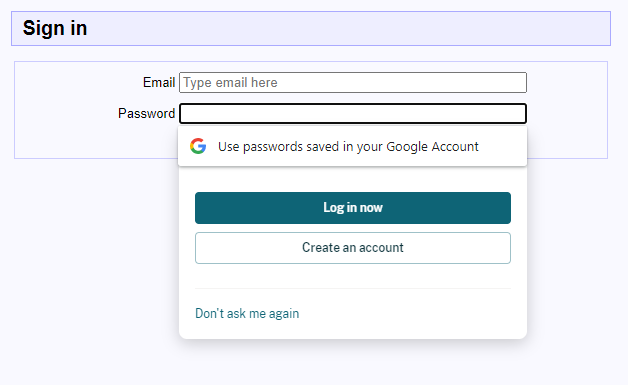

- #Google chrome password manager how to#
- #Google chrome password manager Pc#
- #Google chrome password manager windows#
#Google chrome password manager how to#
How to Change Password with Google Chrome Password Manager? Here you can remove websites and login credentials from the password manager. Move to more actions menu, which is one with the three vertical dots. To add another brick of security, it requires your laptop’s password to view the site’s login details such as username & password. You can also check for the password for that website if you've created any specific password. Go to the saved passwords, click the website names to check what websites you can access through Google Chrome Password Manager. You will be redirected to a page where you can toggle on or off to enable Chrome Password Manager to save passwords and autofill when you access the websites. Open Chrome browser and click on your profile on the top right on your screen and tap password (a key icon along with payment methods, address, and more below your name & profile picture).
#Google chrome password manager Pc#
You can use Google’s chrome password manager to manage your login details separately on your Mac or PC and other devices as well.
#Google chrome password manager windows#
How to manage your login details with Chrome Password Manager on Windows or Mac? Learn to maintain your login credentials and passwords in one go. Here’s How to set up and use Chrome Password Manager efficiently. The Google Chrome Password Manager is not as effective as other password manager apps like Lastpass or Dashlane, but it’s safe & secure as it manages your login details across multiple devices you login using the same Google account. However, it somehow prevents you from picking up the same password for all the websites, which is, of course, a security breach in this cyber world. Also, it generates random passwords for you, which is strong and securely stored in your Google account. The chrome Password Manager is an advanced tool that tracks your login details and passwords for easier & faster login in the future. Just like autofill in Apple’s Safari browser, this one in your chrome browser can track & store the login details you use to access a website, social media account or even your online banking passwords to enable you to sign in with one master password for all the websites you access through Google Chrome browser.


It recently launched a password tracking tool, namely ‘Chrome Password Manager’ whose work basically is to keep your passwords on your fingertips. If you’ve been fed up with tracking your passwords and login credentials, Google Chrome’s new feature can assist you to some extent. It is slightly hard to maintain all the passwords, user details, and other details in mind until you become Carl Gauss or Arya Bhatt. And, it scales up a level harder when you juggle so much on the internet across multiple websites. People are no longer in the habit of remembering things, hence they rely on either notepad or autofill for social media passwords, user login details, and internet banking passwords and other online payment details. Mac/Linux ImplementationĮncryption Scheme: AES-128 CBC with a constant salt and constant iterations.In today’s techno-enabled digital world, it sounds strange to memorize all the passwords, contact, and login details. And obviously this is going to be very useful in trying to decrypt the stored passwords. Now while this can be a very secure function using a triple-DES algorithm and creating user-specific keys to encrypt the data, it can still be decrypted as long as you are logged into the same account as the user who encrypted it.The CryptProtectData function has a twin, who does the opposite to it CryptUnprotectData, which.

Google Chrome encrypt the password with the help of CryptProtectData function, built into Windows. All this information is stored in the clear text except passwords which are in encrypted format. The logins table mainly contains the information about sign-on secrets such as website URL, username, password fields etc. Newer version has moved the login passwords related database into new file named 'Login Data'.This database file is in SQLite format and contains number of tables storing different kind of data such as auto complete, search keyword, ie7logins etc in addition to login secrets. So next time onwards whenever user visits that website, he/she will be automatically logged in using these stored credentials which saves hassle of entering the credentials every time.Ĭhrome stores all the sign-on secrets into the internal database file called 'Web data' in the current user profile folder. Whenever user logins to any website, he/she will be prompted to save the credentials for later use and if user chooses so, then the username & passwords will be stored in internal login database. Like other browsers Chrome also has built-in login password manager functionality which keeps track of the login secrets of all visited websites. Get unencrypted 'Saved Password' from Google Chrome Introduction


 0 kommentar(er)
0 kommentar(er)
